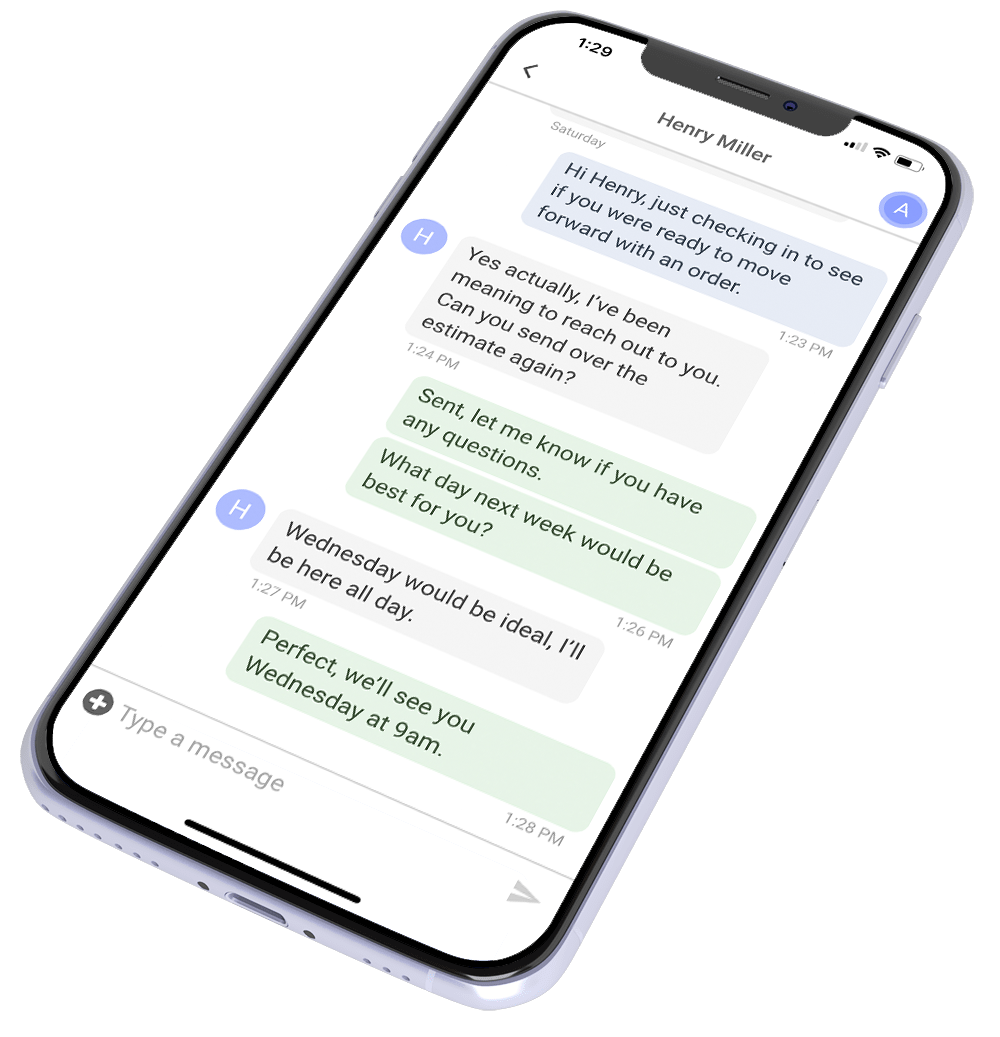
You’ve probably met a fellow roofer who’s said something like this…
“Yeah, I built this business on referrals only.”
Or how about this one?
“We never doorknock. We’re digital only.”
There are two natural reactions.
You either roll your eyes or think, “Gee, maybe that’s why I can’t get any roofing leads!”
But can you really build a successful roofing business with only one lead source? Or do you need to diversify? That’s exactly what you discover in this article. You’ll learn about when you should go all in on one lead source, when you should diversify, and how to test different channels.
The Case for a Single Roofing Lead Generation Source
Masters of a single skill almost always earn more than a jack-of-all-trades. Why? Because the best at something can charge way more than the second best. The top dog in any field doesn’t just set the bar. He moves it up whenever he pleases.
The same goes for lead generation. You’re in control if you become the go-to guy for one type of lead—referrals, online ads, or something else. You don’t need to juggle a dozen methods, trying to keep them all going. Instead, you pour all your effort, time, and cash into making that one source a lead-generating machine.
Once you master that source, you know it inside out. You know where to push, where to pull back, and how to make it work even when the market’s shaky. If it’s working and the leads keep flowing, why reinvent the wheel?
The Case for a Roofing Lead Generation Source Diversity
The problem with a single lead source is that it’s a massive liability. Let’s say you master doorknocking. And for 20 years, it prints money for your roofing business.
But what happens if doorknocking dries up? What if fewer people own homes? Or a global pandemic scares homeowners from opening their doors? Or a competitor carpet bombs your town with the most annoying salespeople of all time?
That’s where the danger lies. You’ve got all your eggs in one basket. If that basket takes a hit, you’re left scrambling. Sure, being the best at one thing is great, but markets shift, rules change, and trends fade. Relying on a single method for your leads turns into a high-stakes gamble. You’re only one bad break away from seeing your leads—and your income—vanish.
Diversifying your lead sources isn’t about chasing the next shiny object; it’s about covering your bases. Think of it like this: one stream can dry up, but multiple streams keep flowing. A strong business doesn’t just bank on what’s working today—it builds insurance for tomorrow. If one channel gets blocked, you’ve got others ready to pick up the slack.
When to Prioritize Single Channels
This isn’t a “Well, they’re both good options, choose the one you want” situation. Instead, they serve two distinct roles in your business strategy. As a rule, you want to start with a single channel. As you grow, you can diversify.
Why? Because focusing on one channel in the beginning lets you build momentum. When you’re small, resources are tight—time, money, even energy. If you spread those thin, you’ll end up spinning your wheels, getting nowhere fast. But when you zero in on a single channel, you go deep instead of wide. You gain mastery. And mastery leads to repeatable, predictable results.
Let’s say you choose digital ads. At first, every penny counts, so you’ve got to dial in your targeting, messaging, and offers. You keep tweaking until you get that channel humming. Once it does, you squeeze it for all it’s worth. By focusing, you grow faster because you’re not dividing your efforts across ten different things. Your business gains traction and you actually start making money instead of just staying afloat.
When to Diversify
It’s time to diversify when you have the resources to experiment. Why? Because now you can afford to take some risks without jeopardizing what you’ve built. Once your main lead source hums along like clockwork, you’ve got extra cash, time, and manpower to explore new channels. That’s when you start branching out—not before.
Diversifying isn’t about chasing shiny objects or following the latest trend because everyone else is. It’s about calculated moves. You’re looking to add channels that complement what’s already working, not distract from it. You test a new method, maybe dip into local events, crank up your referral game, or try out some targeted content marketing. But you do it knowing that if it flops, you’re still good because your main channel keeps delivering.
You want to think of diversification like adding layers. Start with a rock-solid base—your core lead source. Once that’s steady, build on top of it one channel at a time. Each new layer should have a clear role: whether it’s generating new leads, nurturing prospects, or increasing repeat business. You’re not just throwing darts; you’re adding tools to your kit that make you harder to compete with.
And here’s the kicker—diversification doesn’t mean overcomplicating things. You’re still focused. You’re just giving your business extra stability. If one channel takes a dip, another picks up the slack. It’s about staying adaptable while sticking to what works. Diversifying keeps you ahead of market shifts and puts you in control, not at the mercy of changes you can’t predict.
The key? Don’t diversify too early, and when you do, do it with purpose. Diversification should feel like a growth strategy, not a desperation move.
How to Test Lead Sources
Don’t go off your gut. When you’re choosing your lead source, test like a scientist. Here’s how!
Lead Tracking
First things first—track your lead sources! Early on, it’s easy to know where your leads come from because you’re probably handling most of them yourself. You remember which call came from a referral, which customer found you through Facebook, and who answered that door-knock. But as you scale, things get messy. Suddenly, you’re running ads, sponsoring events, and doing follow-ups, and it’s easy to lose track of what’s working and what’s burning your budget.
This is where lead tracking becomes crucial. You need to know, with precision, where each lead originates. Start simple—track every inquiry, every call, every form fill. Tag them by source, whether it’s a Facebook ad, a yard sign, or a neighbor’s recommendation. Without this data, you’re flying blind.
Gross Profit to CAC Ratio
Let’s break it down by focusing on the gross profit to CAC ratio. This is where the rubber meets the road in testing lead sources. Most roofers focus on revenue, but that’s a mistake. Revenue’s a vanity number—it’s not what you actually pocket. Gross profit is what counts because it’s the money left after you do the job.
But before we talk gross profit, let’s dissect CAC—Customer Acquisition Cost. CAC isn’t just your ad spend. It’s the whole nine yards. Start with ad spend, sure, but factor in software costs for your CRM, salaries for your sales team, and commissions for anyone closing deals. Every dollar you pay to generate and secure that customer counts. Whether it’s your Facebook ad budget or the gas your sales rep burns door-knocking, it’s all part of the CAC.
Now, let’s shift to gross profit. This isn’t revenue. Revenue tells you what came in. Gross profit tells you what’s left after you actually do the job. Gross profit is what’s left after you pay for shingles, nails, underlayment, and the crew’s time. It’s what you keep once you’ve replaced that roof and settled all job-specific costs. You can land a $20K contract, but if labor and materials eat up $18K, you’re only sitting on $2K gross profit.
So when you compare your gross profit to your CAC, you get a clear picture. If your CAC eats up too much of your gross profit, that lead source isn’t worth it. You’re not in this game to just move money around; you’re here to make money. Focus on the ratio: how much you spend to get the customer versus what’s left after you finish the job. That’s the real test of whether a lead source is worth your time and investment.
Here’s a hypothetical comparison of Gross Profit to CAC for two common lead sources: Facebook ads and doorknocking, with the ratios included.
Facebook Ads:
- You spend $2,500—covering ad spend, software tools, and part of a salary for campaign management.
- If your gross profit is $5,000 after labor and materials, your Gross Profit to CAC ratio is 2:1 ($5,000 gross profit divided by $2,500 CAC).
Doorknocking:
- Your CAC is leaner—around $500, covering gas, commissions, and maybe a small sales rep salary.
- With a $5,000 gross profit, your Gross Profit to CAC ratio is 10:1 ($5,000 gross profit divided by $500 CAC).
In this example, doorknocking knocks the socks off Facebook ads. For every dollar you put into doorknocking, you get $10 back. For every dollar you put into Facebook ads, you get $2 back.
Now, if you’ve maxed out your doorknocking, Facebook ads aren’t a terrible investment. But in this example, you’d probably want to test other roofing lead generation sources first!
We have a quick video explaining this concept. It’s under a minute long, so check it out.
Conclusion
Now that you’ve got the full picture, the next move is clear: take charge of your lead strategy like it’s your bottom line—because it is. Don’t sit back and wait for leads to trickle in. Make deliberate, calculated moves. Start by mastering one lead source—dominate it, wring every drop of value out of it, and watch your business grow. Once you’ve locked that down, don’t get complacent—add layers, test new channels, and always keep an eye on your Gross Profit to CAC ratio.
Remember, this isn’t a guessing game. The numbers don’t lie, and they’ll tell you exactly where to double down and where to pivot. Whether you’re door-knocking with grit or scaling up with digital ads, every dollar and every lead should work hard for you.
So get out there—track your leads, calculate your costs, and start taking action. Because the future belongs to the roofers who don’t just adapt—they own their game, one lead at a time.
Need a CRM that makes tracking lead source easy? Check out ProLine! It helps you record the source of every lead that enters your process.



